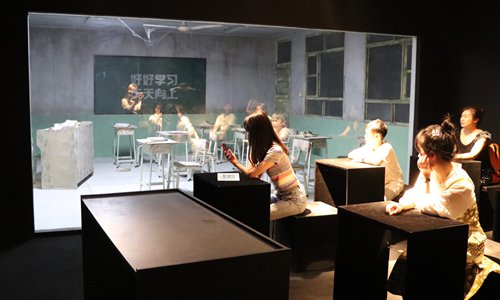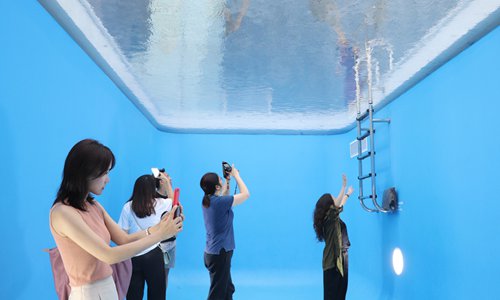HOME >> ARTS
Exhibition exploring Chinese culture by artist Leandro Erlich becomes hit in Beijing
By Bi Mengying Source:Global Times Published: 2019/7/25 15:23:40

Visitors take photos at The Confines of the Great Void exhibition in Beijing on Monday Photos: Liu Zhongyin/GT

Visitors take photos at The Confines of the Great Void exhibition in Beijing on Monday Photos: Liu Zhongyin/GT
While Argentinean artist Leandro Erlich has previously held exhibitions in Shanghai, the one that kicked off at the CAFA (The Central Academy of Fine Arts) Art Museum on July 11 is his first in Beijing.
While the cities have changed, the popularity of his work remains the same. Numerous positive reviews have continually poured in for The Confines of the Great Void exhibition, which looks like it will remain popular until it finishes its run on August 25.
Art and social media
Erlich is a conceptual artist whose work has been exhibited internationally, including at the Venice Biennial and Whitney Biennial.
His artworks are known for their interactive nature. Viewers can have fun exploring his works at the same time they try to uncover the concept behind them. The high degree of interactive participation in his works enables the viewers to easily capture interesting photos and then post them online.
"With the internet and social media and a wider audience learning about his work, he has actively inspired audiences all over the world, which has produced even more interactive participation and endless pictures on social media," wrote Zhang Zikang, the curator of CAFA Art Museum, in an article published on the museum's social media account.
A simple search of the hashtag #Leandro Erlich on Instagram returns more than 34,000 posts. On Chinese Twitter-like Sina Weibo, the total views of posts discussing the exhibition at the CAFA Art Museum has reached 3 million.
"Through his art, people realize that artistic forms can penetrate public spaces and be collectively changed by visitors and the artist. This is the unique charm of Erlich's work. He gives us the opportunity to consider contemporary art and its exhibition, and ways of creating all-new viewing relationships with visitors, catalyzed by new media culture," Zhang added.
West meets East
A house suspended from a crane with "roots" attached to its base can be seen from afar outside the main building of the CAFA Art Museum. The house appears to have been uprooted from its location like a tree, hence the artwork's name Pulled by the Roots.
"In the modern era, we are tempted to see human innovation as inorganic and divorced from the natural world… The speed of technology and the increasingly virtual dimension in which many of us live only encourages this tendency to separate our inventions from the earth that sustains us," Dezeen, an architecture and design magazine, quoted the artist as saying when explaining the meaning behind the work.
He further noted that Pulled by the Roots highlighted that tension.
"As living beings on an ever-changing planet, we can never be apart from the organic world; the architecture that we create is part and parcel of our environment… As we consider our impact on the natural world, climate change and the fate of the oceans, this piece reminds us that human culture and nature are intimately linked," he added.
Yet the uprooted house at the exhibition looked different from his work exhibited in other places, as the house presented a strong Chinese style.
"The artist did his homework before exhibiting his work in China. He read some Chinese books while he was in Argentina, such as Dream of the Red Chamber, which is regarded as one of the four most famous classic Chinese literary works. He was intrigued by the book, as many stories and traditional Chinese moral concepts from it were rather refreshing and foreign to Westerners like him. The title of the exhibition was inspired by a chapter from the book as well," Zhang told the Global Times.
Meanwhile, Zhang also pointed out, "artists nowadays are not that conscious about the boundary between Western and Chinese culture. Because of globalization, they are exposed to different cultures. Erlich may be interested in Chinese himself, that's why he tried to incorporate Chinese elements into some pieces of his work for the exhibition."
Bringing art to everyone
Bringing knowledge to people to educate and benefit the public is one of the missions of the CAFA Art Museum, said Zhang. He said he believes that exhibition such as Erlich's can be beneficial on many different levels.
As the museum affiliated with CAFA, an academic institution, the museum tends to put great focus on academia. However, academic-focused exhibitions may not be accessible to the general public, who lack expertise on the fine arts. However, the exhibition by Erlich has gained recognition from academics as well as proving popular with the public.
"I hope this exhibition can inspire Chinese artists in terms of creation and innovation, and provoke art museums in China to reflect upon how to make art more accessible to the public," said Zhang.
"Due to the interactive participation of Erlich's work, many people who may not be that interested in art have been drawn to the museum and gained a new understanding about art museums. They'd see that art museum are not that far away from their lives. Exhibitions like this, can actually bring art museums closer to the public."
Newspaper headline: 'Confines of the Great Void'
Posted in: ART,CULTURE & LEISURE